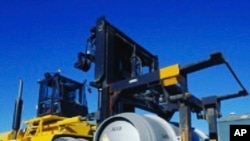The United Nations’ atomic watchdog agency has confirmed reports that Iran has begun operating centrifuges installed at an underground site but says the country’s overall uranium-enriching capabilities have not significantly increased.
During a Wednesday news briefing in Vienna, International Atomic Energy Agency Director General Rafael Grossi told reporters the 174 centrifuges had been moved into a new area of Iran’s Natanz nuclear site and had recently begun operating.
He said the operation of centrifuges of that type was in violation of the Iran nuclear deal signed with world powers in 2015, known as the Joint Comprehensive Plan of Action, or JCPOA. Grossi noted the operation would not lead to a greater overall output of enriched uranium.
But he said Iran was already far past the deal's limits on enriched uranium.
“In general terms, there is no significant increase in the volumes, since as I mentioned, they had already been operating in a different place. So, it's a nuance there. But of course, it is something that is not within the limits of the JCPOA,” Grossi said.
Grossi said Iran has been asked to explain the discovery to IAEA investigators, but the explanations “have not been satisfactory.”
The Associated Press reports a confidential document distributed to member JCPOA countries last week show Iran as of November 2 had a stockpile of 2,442.9 kilograms of low-enriched uranium. This was up from 2,105.4 kilograms reported on August 25.
The nuclear deal signed by the United States, Germany, France, Britain, China and Russia allows Iran only to keep a stockpile of 202.8 kilograms. The IAEA said Iran has also been continuing to enrich uranium to a purity of up to 4.5%, higher than the 3.67% allowed under the deal.
Iran has openly announced all its violations of the nuclear deal in advance after President Donald Trump's 2018 decision to pull the U.S. out of the deal.
The New York Times reports President-elect Joe Biden has expressed interest in rejoining the pact.






